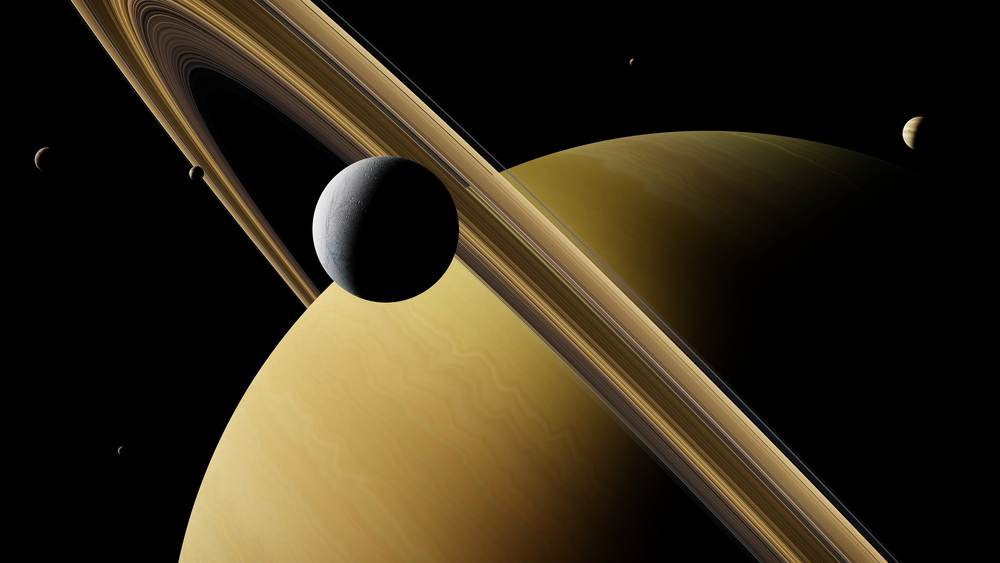Saturn Has 146 Moons — How Many Moons Do These 5 Other Planets Have?
Posted on Categories Discover Magazine

How many moons are in our solar system? First, it would help to understand that a moon is an object that’s formed naturally and orbits around a planet.
The Earth’s Moon is well known. It’s the brightest light in the sky, and you can see it most nights. But there are many more moons in the solar system, and some of them have pretty interesting stories.
According to the most current count from NASA, there are 293 moons in our solar system and likely more to be counted. Let’s take a look at some of the most memorable moons to date.
1. Mars
(Credit: Vadim Sadovski/Shutterstock)
With two small moons orbiting the Red Planet, Mars’ moons, Phobos and Deimos, are basically just captured asteroids. The larger of the two, Phobos, orbits around the planet twice daily, while Deimos circles Mars every 30 hours. Phobos is also getting closer to Mars and will likely collide with the planet in 50 million years.
2. Jupiter
(Credit: Vadim Sadovski/Shutterstock)
Jupiter is huge—11 times larger than Earth, to be exact—and as a result, it has many moons. With 95 moons and counting orbiting this mega planet, there are sure to be some objects of interest, says Alex Gianninas, an astronomer at Connecticut College in New London, Connecticut. Most of Jupiter’s moons are rather small, but a few of them stand out.
“Europa is really interesting because it has a thick layer of ice around it, but underneath that ice, astronomers theorize that there’s a liquid ocean made of actual water,” says Gianninas.
He adds that the water remains liquid because Jupiter exerts a force on the moon that makes it flex, pumping heat and energy back into it and keeping the water liquid. This also adds to the potential for some kind of life on Europa.
3. Saturn
(Credit: Dotted Yeti/Shutterstock)
As of last year, Saturn had 146 moons in its orbit. This gassy giant also has some gems. In a recent study published last month in Science Advances, researchers explored how Saturn’s largest moon, Titan, has oceans and lakes brimming with methane.
“Titan is the only other place in the universe that we know of so far that has active rivers and coasts,” says study author J. Taylor Perron, a professor of geology in the Department of Earth, Atmospheric, and Planetary Sciences at the Massachusetts Institute of Technology in Cambridge, Massachusetts. It rains on Titan, and although that rain is made of methane, there’s a similar hydrological cycle as you would find on Earth.
4. Uranus
(Credit: Vadim Sadovski/Shutterstock)
Uranus has 28 moons, including the “Literary Moons” named after Shakespearean characters. Some favorites include Miranda, Ariel, and Umbriel. Miranda is a neat choice because, though smaller than our moon, she has craters that are 12 times deeper than the Grand Canyon. And with low gravity and deep cliffs, it would take 10 minutes for a stone to hit the foot of its canyons if dropped off the edge of its highest cliff.
5. Neptune
(Credit: Vadim Sadovski/Shutterstock)
Icy Neptune has 16 moons to call its own, named for Greek sea gods just like the planet they orbit. Triton is the largest of Neptune’s moons, and because it was captured by Neptune’s gravity, it’s one of the few known bodies to have a retrograde orbit, meaning it moves in the opposite direction.
6. Pluto
(Credit: Vadim Sadovski/Shutterstock)
The dwarf planet Pluto has five moons of its own with neat names like Styx, Nix, and Hydra. Its largest moon, Charon, is nearly half the size of Pluto, making it the largest moon relative to the planet it orbits.
Article Sources
Our writers at Discovermagazine.com use peer-reviewed studies and high-quality sources for our articles, and our editors review for scientific accuracy and editorial standards. Review the sources used below for this article:
Sara Novak is a science journalist based in South Carolina. In addition to writing for Discover, her work appears in Scientific American, Popular Science, New Scientist, Sierra Magazine, Astronomy Magazine, and many more. She graduated with a bachelor’s degree in Journalism from the Grady School of Journalism at the University of Georgia. She’s also a candidate for a master’s degree in science writing from Johns Hopkins University, (expected graduation 2023). Find her on socials @sarafnovak